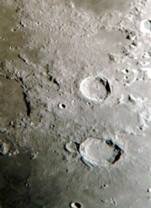 The craters Eudoxus (top) and Aristotle (below) on the Moon.
The craters Eudoxus (top) and Aristotle (below) on the Moon.Mathematician and astronomer; b. c. 400 BC (Cnidus, Ionia) d. c. 350 BC (Cnidus)
 The craters Eudoxus (top) and Aristotle (below) on the Moon.
The craters Eudoxus (top) and Aristotle (below) on the Moon.
Eudoxus came from the Pythagorean tradition that regarded mathematics as the key to astronomy. He made substantial contributions to number theory, began the necessary interaction between observation and theory in astronomy and gave the first systematic explanation of the motions of the Sun, Moon, and planets. None of his writings survived; but his contributions are recorded in many Greek sources and in commentaries from later Byzantine times. What is known about the life of Eudoxus is derived from the writings of Diogenes Laërtius from the 3rd century AD.
Eudoxus, the son of Aeschines, was born in the Greek city of Cnidus in today's Turkey. Cnidus had a well known science school, and Eudoxus got an excellent education in mathematics and medicine. He was such a good student that a wealthy physician sponsored him to travel to Athens and join Plato's recently established Academy.
After his time at the Academy Eudoxus travelled to Egypt, where he stayed in Heliopolis (today a suburb of Cairo) for 16 months to be initiated in the knowledge of priests. A large part of this training was astronomy, and Eudoxus wrote his first major work Octaëteris, a treatise on the calendar, during this time. Eudoxus then travelled around the Sea of Marmara working as a teacher before he eventually returned to Athens, where he became known as a respected legislator.
Eudoxus greatly developed mathematics and was instrumental in bringing together observation and theory in astronomy. Euclid used much of his work in his Elements; books V and XII and much of books VI, X and XIII are believed to be essentially Eudoxus' work.
Eudoxus' major contribution to mathematics are his "method of exhaustion" and his "theory of proportion", essentially the introduction of irrational numbers. Before Eudoxus mathematicians could deal with fractions (such as 7/13), known as rational numbers. But Pythagoras' discovery of the relationship between the sides of right triangles had shown the existence of numbers that had no finite fractional expression, such as the square root of 2 = 1.414213... with a never repeating infinite sequence of digits.
Eudoxus showed that any irrational number can be approximated to any degree of accuracy by rational numbers. He called this major contribution to number theory, treated in detail on book V of Euclid's Elements, the theory of proportion.
The method of exhaustion, described in minute detail in book XII of Euclid's Elements, used approximations to deal with irrational numbers in the calculation of areas and volumes. A circle, for example, can be approximated by a series of polygons, for which the area is known exactly, with smaller and smaller sides. Eudoxus thus combined his theory of proportion with the idea of the infinitesimally small length, the basis of integral calculus that was developed by Leibnitz and others in the 17th century.
Eudoxus' contribution to astronomy was equally fundamental. Starting from the Greek conviction that the universe is built on simple and beautiful principles, Eudoxus devised a system of concentric spheres and described their movement relative to each other mathematically. The stars were affixed to the outermost sphere; other spheres served to explain the movement of Moon, Mercury, Venus, the Sun, Mars, Jupiter and Saturn. The apparently irregular movement of the planets was modelled through the combination of differently rotating spheres.
This mathematically admirable system could account for the movement of five of the seven heavenly bodies; it did not give a satisfactory result for Venus and was totally inadequate for Mars. Its major impact on astronomy was the concept of spheres within spheres, which survived for over 2,000 years, refined by Ptolemy during the 2nd century AD, before it was replaced by Kepler's Laws.
The Phainomena, a work of Eudoxus now lost, is the earliest known Greek source that describes star groups as constellations. Constellations assist astronomers and navigators to locate certain stars, and their use for navigation at sea was of paramount importance for the Greek merchant class. The study of cuneiform documents indicates that the Greek constellation system was probably inherited from the Sumerians of Mesopotamia and came to the Greeks through the Phoenicians, possibly through Thales.